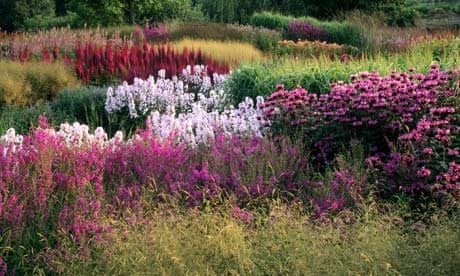How do you stop yourself indulging in plants when the array is irresistible? Too much choice has a downside: our gardens become eclectic collections – a disjointed jumble on which the eye struggles to rest. Sticking to fewer varieties and planting in bigger sweeps has greater impact and is better in terms of design, but it is hard to maintain one's resolve: I often succumb to a mouthwatering plant without a clue where it's going to go.
Break it up with spires
Scale is important, too. Smaller spaces and narrower borders can take smaller groups without becoming bitty. The larger the space, the bolder you can be. Try using perhaps eight of a variety in a sweep rather than ones or twos and see how dramatic this can be. And why not plant 50 of one variety of tulip through an area instead of five or 10, so that you have unity and impact in one.
How do you stop mass planting becoming boring? Breaking up groups into smaller numbers, then repeating throughout the area to form a tapestry is one option. Visual interruptions of uprights rising above your blocks is another, to add height and draw your eye through the space. Good examples are bronze fennels, yellow or white mulleins, tall umbels like the green flowered Peucedanum verticillare, thalictrums such as 'Elin' with purple-tinted young foliage or the daintier T. delaveyii with froths of mauve flowers, and our good friend Verbena bonariensis rewarding you in late summer with electric mauve clusters.
Which plants work well?
wood anemoneastrantiarudbeckialibertiaAsplenium scolopendriumSmyrnium perfoliatumAnother good association could be the white umbel Seseli libanotus with the purple-tinted foliage of the upright Thalictrum 'Elin'. The free-flowing, green-bladed grass Hakonechloa macra could add movement and a different shape altogether with white variegated Miscanthus sinensis var condensatus 'Cosmopolitan'. The opaque pinky green flowers of Astrantia major 'Shaggy' could be repeated throughout. Self-sowers such as blue forget-me-nots for the spring, the silver sea holly Eryngium giganteum 'Miss Willmott's Ghost', the dainty pink and white Mexican daisy Erigeron karvinskianus and mauve Verbena bonariensis could follow for summer support. A thin scattering of opium poppies and tall yellow verbascums would finish off the combination.
Anchor with evergreen structure
Salvia officinalis 'Berggarten'Drift planting needs careful thought, as the emphasis is on only a few plants. Those chosen have to perform on their own and also within a unit. The harmony created by repetition and restricting choice can easily be disturbed. The urge to pop in new things is always there and one needs self-control.
Good drift partners
In shadeIn sun The white umbel Seseli libanotus with upright Thalictrum 'Elin' with grasses to add movement.
